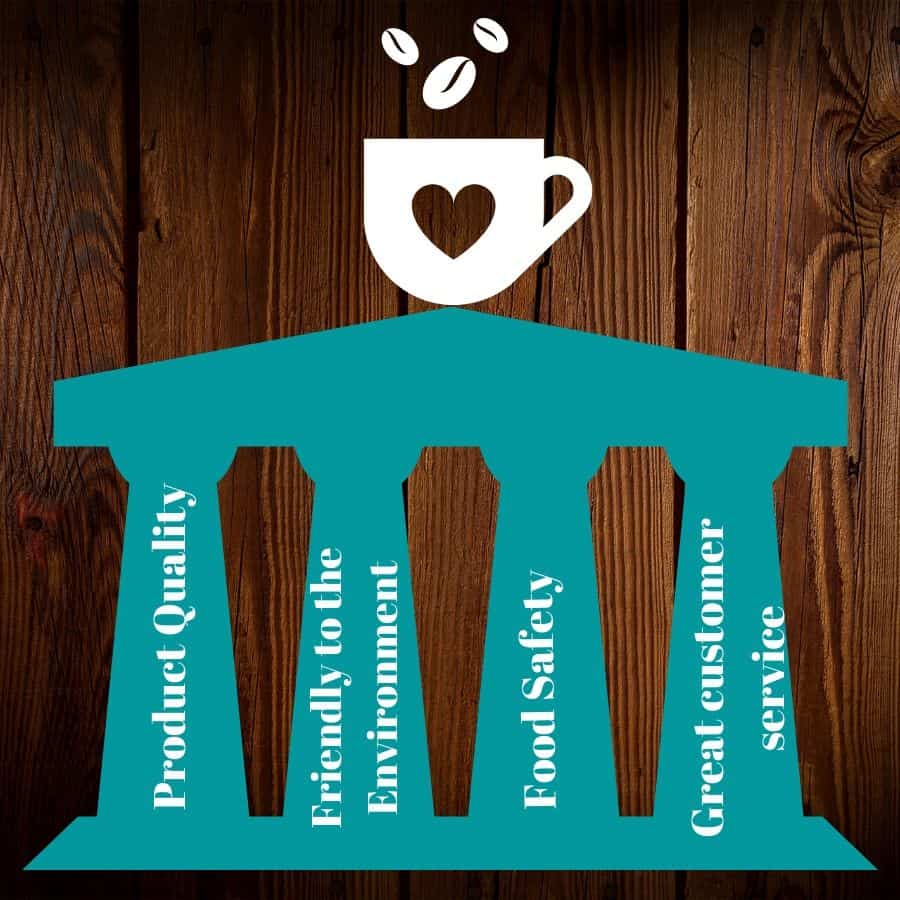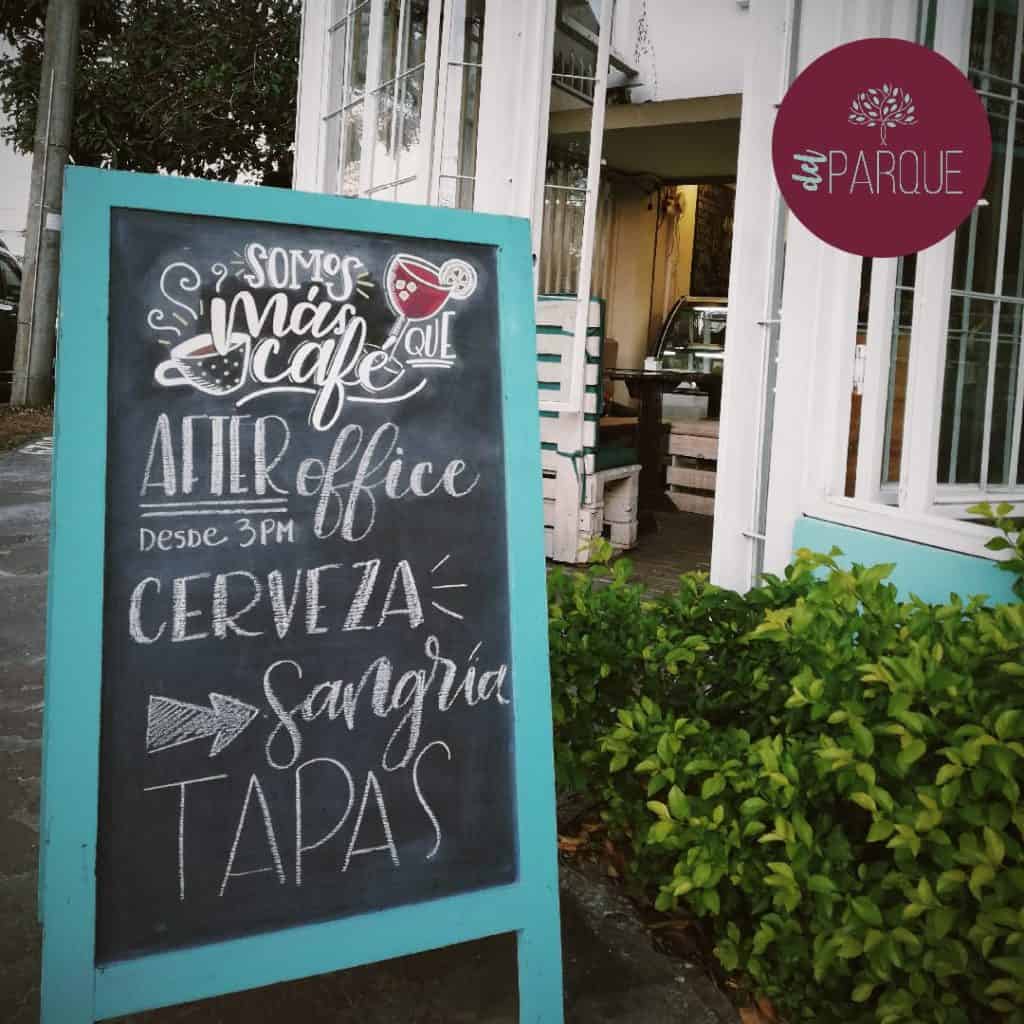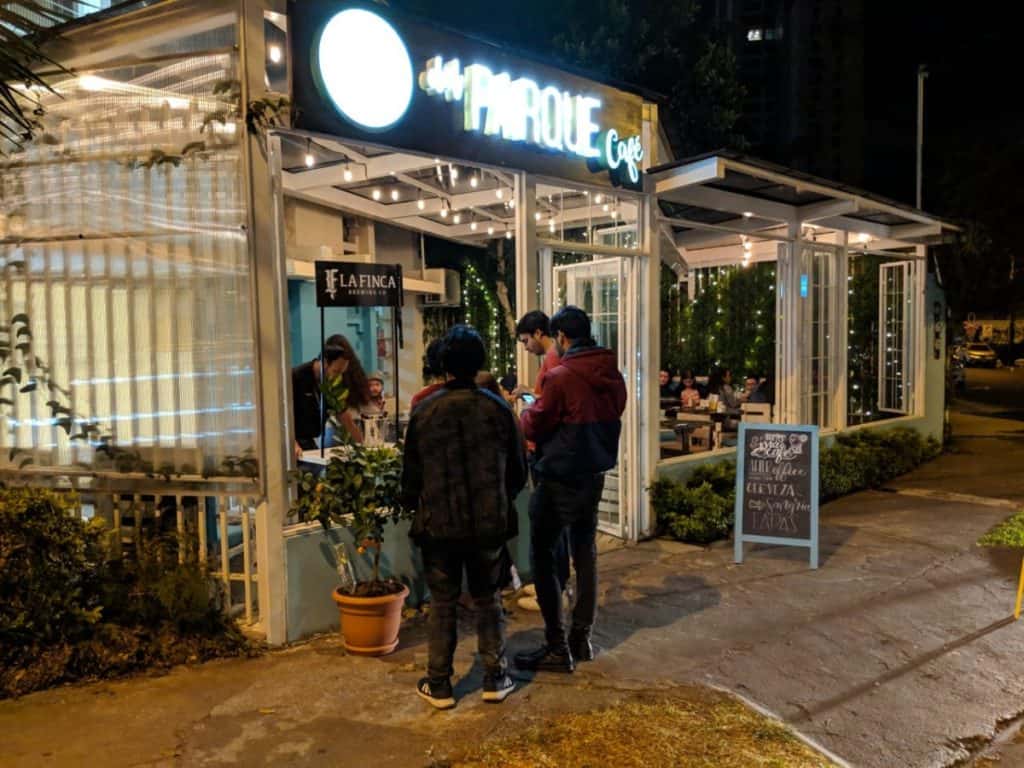
As coffee shop owners, we had to learn the tough way how to plan and run our business. We still keep learning every day.
There is only so much you can read and research about, and a lot you just have to live to gain insight.
Nonetheless, it is handy to know the core principles that we have learned and would have loved that someone told us beforehand to ease the way and improve results.
The following are 6 steps to run your coffee shop:
- Have a vision, goals and core values set up
- Know your numbers
- Make a tactic plan to reach those goals
- Manage employees
- Have a system in place
- Measure performance, adjust and continuously improve
- Decide which tasks to delegate
Easier said than done right? Well yes, but let’s dive deeper into these concepts so you can get a more profound sense of what we mean by all of them. Carry along with this post for all this and more.
1. Have a vision, goals and core values set up

What is your vision for your coffee shop? How do you envision your life running a coffee shop? Are you going to manage for someone else or your own?
Having a clear vision and goals is the number one step for achieving success. And for running your coffee shop, you must remember them constantly.
These goals can slightly change through time as your coffee shop matures as well as you as the owner or manager, however, this clear end goal in mind will help you align efforts and actions, and keep you from derailing.
Also, what is your target customer? Who are you aiming to sell to? This will influence the design of your menu, your pricing, the layout of your coffee shop. Who you want to sell to and what their needs are is crucial for running your business.
For example, we decided that the concept for our coffee shop was going to be: a place where people felt it was an extension of the park, where they felt comfortable while eating and drinking amazing food at a not so expensive price. “A little coffee place to fall in love with” was how we described our place.
In turn, our core values were established alongside this concept: great customer service, great food at a not so high price value, environmentally friendly and food safety would be at the top priority.
Finally, having this in mind we established in how much time we would break even, and what this meant in terms of sales, costs, and expenses. This is also very important, to know your numbers.
You may also want to read: What are core values?
2. Know your numbers

After having set up our goals, we knew how much sales we would have to make at the end of the week to reach our month’s goal. Also, we knew what this meant in terms of daily sales, the number of customers, and the average ticket per customer.
We memorized this number and kept it as a reference until we were able to break even and beyond. This was a way to know good days from bad, and good months from bad ones. But also, a good way to devise a plan to reach these numbers.
On the other hand, we also knew how much gross margin each product had. For this, we had calculated the cost for each item and subtracted it from the price.
Pricing was done taking into account competition, the concept for our coffee shop but also the gross margin.
We also determined an average decrease percentage. This was because we knew it would be difficult for employees to always use the same amount of ingredients.
For example, ham would not always have the same weight per slice or use the same amount of spread for sandwiches. So we preferred to play safer and decided to include a certain percentage of a decrease in the cost of the product.
You may want to read: gross margin for a cup of coffee
Finally, we also knew what our fixed costs would be. We had an agreement with the landlord for the rent wage, a fixed salary for our employees (which later found was a mistake and would have preferred a variable commission based on sales), and an estimate for other costs like water and electricity.
For establishing these numbers we talked to similar business owners for advice.
Also, we knew how much gross margin we were making with each sold item. We were aware that we had to take care of our costs to pay for all the bills.
Your food costs can become a Bermuda triangle, where things just might start to get lost and you do not even realize it.
It is very important to know how much you should be spending on food in terms of total sales, and how much waste you can handle. There is a lot of hidden money in food waste or even food robbery, and this aspect should be handled carefully.
All these aspects were calculated after months of researching, analyzing, and talking to other business owners.
3. Make a tactic plan to reach those goals

After establishing your vision and goals, and knowing what this means in terms of numbers, make a tactic plan to reach them.
For example, for increasing sales, you may have a strategic goal that establishes something along these lines:
- Establish a loyal local customer following that loves our coffee shop
- Deliver great quality products
- Become the reference point in our local area
So let’s now dive into the first one of these goals: to establish a loyal customer following. And what it could mean in terms of establishing tactic tasks that allow you to reach this goal.
Continuing with the example, let’s say the following three components will be the rundown for the goal:
3.1 Communicating with your customers: internal and external
3.2 Strive for great customer service
3.3 Gather customer’s emails and then communicate with them constantly
3.4 Organize events for your customers
Let’s dive deeper into each of these components.
3.1 Communicating with your customers: internal and external

This aspect is very important to communicate constantly with your customers. It can be seen from two different points of view: internal and external communication.
Internal communication refers to your menu boards, menu papers, how you display promotions inside your coffee shop. It refers to making it clear for your customers what your products are. It can also mean having pictures or a food display right upfront.
When thinking about internal communication it is useful to follow the same route that the customer does when entering the coffee shop, and trying to see if it is easy or difficult for them to figure out what your products are and their perceived value.
On the other hand, there is external communication. Which means what you communicate to people that are outside your coffee shop or that have not entered.
How do you attract customers that are just passing by for them to come inside? How do you tell people from outside what is to expect inside? This is also something to consider so that you can attract new customers, and hopefully, some portion of those can later become loyal ones.
Another important aspect of communicating with customers is social media. This can also be a great tool for communicating externally and attracting new customers. There are many social media platforms. We have mostly been using Facebook or Instagram.
But also, social media will be key to marketing and promoting your business, and not just communicating with existing customers. It is where you will probably display your promotions, where you may decide to pay for publicity. It can also help you figure out what your public is depending on the demographics.
Be careful though, as many of your followers on the social media platforms may not be direct customers for your coffee shop. And also, many of the people that interact with your posts may never enter your coffee shop as well.
So understand that there are the two audiences: the ones in your coffee shop which sustain your business and are your most important audience, and the ones in your social media platform which help the growth of your business but in my experience are secondary.
Taking this into account, how will you be marketing and promoting your business. Will you be using social media and if so what platform? These days we have seen an uprise on using Instagram, but then, this platform can also be more familiar for younger people and Facebook for older people. Who is your customer?
3.2 Strive for great customer service

Determine what this means to you or your coffee shop. It may signify to have a welcome and goodbye protocol so that employees always serve the customer the same way.
For example, a welcome protocol may include instructions for guiding the customer to order. The goodbye protocol may include saying thank you with a smile.
It may also mean to serve to the table or order in the counter. To always serve drinks first, and food afterward.
You will establish what are the terms for striving to great customer service, and then follow along those lines.
How is your customer living the experience in your coffee shop, from the moment they walk inside to the moment they leave?
Friendly staff was determined to be the number one factor for the success of coffee shops, in a study conducted by the Univesity of the West of Scotland (2018) by Douglas et al. called “Investigating the success of independent coffee shops and cafes in the UK”.
Great customer service is a sure way to start gaining recurrent customers that will keep your business up and running.
Determine what is your desired level of customer service and organize staff and systems accordingly. Your customers are the reason your coffee shop exists, and everything should revolve around them.
So now that you have established what your desired level of service is, then your employees will be critical to keeping up with this level.
Your employees should be able to connect with your customers in a non-invasive subtle matter. This in turn will help them to offer additional products to increase sales.
For example, if a customer is satisfied with the coffee and asks for its origin, the employee can offer them a coffee bag. When buying coffee they can offer a dessert. When recommending products, they can do so with the confidence of having good quality items.
Treating customers in a way you would like to be treated can be crucial for your business. And after doing this selling them more is allowed.
In the beginning, we would feel guilty about receiving people’s money. But then we realized, that we were offering a service and an experience, and we were doing our best for it to be of quality.
We were offering a great space with great food for people to be happy, to enjoy their times. And we needed the money in exchange for our service to survive.
So it is important not to think this way for it can hinder your income and business. Treat customers the way you would like to be treated, offer them a great service and product, and then charge accordingly.
3.3 Gather customer’s emails and then communicate with them constantly
So this can be another task to perform to establish a loyal customer following. By grabbing people’s emails and phone numbers you can let them know about new product launches, promotions, or offers.
It is a way to stay present in the mind of your loyal customer’s mind. Have in mind though, that many people do not read emails so do not expect everyone to be aware of your communication. But some percentage will, and with consistent communication, you will start to build a loyal following and understand what resonates with them.
It is also important to avoid being seen as spammy so this really has to be analyzed to contribute to the relation between the customer and the coffee shop, and not the other way around. It should be a tool to connect.
3.4 Organize events for your customers

Events like coffee tasting, or showing different brewing methods for customers are activities that you can do to enhance connection and deliver greater value to your customers.
Also, other types of events like organizing baby showers, birthdays, stand up comedy or live music. Events can become very important to minimize the uncertainty of people coming in.
If you can have an event agenda, you can plan accordingly for an estimated volume of people, that with time can be a reliable way to have constant customers.
So all of the above four tasks discussed can be done to pursue the achievement of your strategic goal of acquiring a loyal customer base.
You will need to do the same for all of your goals. Some will interconnect. For example, for the goal of becoming a reference point you could also use the tasks mentioned before.
Also, it is important that your employees know these goals and the tactic associated. They must know what their role is in achieving them.
4. Managing employees

I believe this may very well be the most difficult part of running a coffee shop: managing your employees. They are so critical to the success of your business. They represent the essence, the brand.
The image of your coffee shop will be at the hands of your employees, they are by far your most important resource and thus must be treated as such.
First, determine what is the profile of the person you wish to hire. Ask your self what level of education you require, what skills and competencies they should have.
Are you searching for an experienced person, or you prefer someone that is just starting so you can mold them?
Try to be specific on your needs and then take your time to interview and ask questions that can allow you to see if the person complies with what you are asking. Ask for references as well.
Try to be as precise on your hiring as possible, although, I believe there is also a little bit of luck involved when hiring someone. There is only so much you can know from an interview. So trust your intuition as well.
When you are about to hire the person make sure they understand exactly what will be expected of them. What their responsibilities are. Ideally have it in writing.
Then, establish clear rules to follow and systems to evaluate. This aspect will be discussed next.
5. Have a system in place

Okay so at this point you have your strategy set up, your tactic, now you must have a system for executing and measuring performance.
5.1 Sales
What Point of Sale System will you be using? What metrics can this system give you to track sales? For us we used Loyverse and could look at general sales, sales per ticket, number of customers, margin, frequent customers, amongst other data.
5.2 Inventory management
Have a system that allows you to know what inventory you have if you need to buy more of something of not. Then, try to understand what this value is in terms of percentage from your sales. This way, at the end of the month you can calculate your sales and inventory, and see if it’s on your target percentage or not.
This system can mean adding your materials to an inventory tracking program. But, it can also mean that you manually count items and write them down on a spreadsheet. Whatever works for you, the important thing is to keep track of inventory. How you do it is up to you.
Using a program, and especially one that synchronizes with your point of sales system is a great alternative because it can automatically deduct inventory from the system if you have recipes en place. However, maybe for you, it works better to manually count every item and then analyze it in a sheet of paper.
The most important thing is to use a system, one that works for you, so that you know what you have to buy, where you are losing unnecessary money, and how employees are handling ingredients.
It is important to say though that tracking decrease is more difficult when handling inventory manually than using a program, but it can be done.
Make sure that your employees know that you are on top of the game when it comes to handling ingredients because this will also send a signal for them to be careful around food waste.
5.3 Customer feedback
A system for customer feedback can be done in many ways. For example, you can make surveys to customers to gather their opinion.
You may also hire a mysterious shopper agency that gives you a rating on your performance. This option I believe is amazing if you can afford it, for your employees will never know who the mysterious shopper is, and therefore should be vigilant to treat everyone the best they can.
5.4 Employee mentoring and performance
Have a system for mentoring and giving feedback to employees. Try to have meaningful conversations where you tell them what you believe they are doing okay as well as where you believe they need to improve.
Sometimes employees do not know this and believe they are doing their job okay while having major areas to improve. If you have a system for constant feedback this will help you with the management.
A system may mean regular sessions once a week, or scheduling 10 minutes a day once a week per each employee. Whatever works for you, just make it consistent.
Remember, customers are the center of your coffee shop, but employees are the heart and soul. They are a direct representation of your management skills. If they make mistakes, it is not just their responsibility, it is also yours.
Customers are the center of your coffee shop, but employees are the heart and soul.
This is another aspect we learned the hard way, after many mistakes from our employees, we came to realize that it was not just their mistakes, it was ours as well. So taking responsibility eases the way and allows you to solve situations faster. It is not a problem to make mistakes, the problem is to not learn from them and keep making them.
Also, it is important to ask employees what you as a manager can do to ease their job. Having one on one sessions with your employees is a great tool for connecting and having more motivated people.
Remember, customers are the center of your coffee shop, but employees are the heart and soul.
5.5 Cleaning schedules
Having a routine for cleaning is critical. You must establish which areas need a daily or hourly cleaning and sanitizing routine, and which require a weekly or monthly routine. Establish also what products you will use and how to use them.
6. Measuring performance, adjusting, improving
Having metrics that indicate if you are close or far away from achieving your goals is also critical. It is the output of your driving system and allows you to make adjustments.
It is here where your management will enter a continuous improvement cycle. Execute, measure, and improve. If you do this you will see continuous sustainable improvement over time. Maybe not the first day or the second day, but definitely through time.
What things will you be measuring? It will depend on your strategic goals, your tactic, and your systems. It must all make sense. What information is key for you to know if you are doing okay or not? Try to think about this.
7. Decide which tasks to delegate

If you are the owner of a small coffee shop many other tasks will be required such as accounting, social media management and or graphic design, buying from suppliers, paying salaries, paying your suppliers bills. There are just tons of tasks involved.
All this while supervising the daily operation, making sure quality customer service standards are met, giving feedback to employees, etc. As a manager of a coffee shop, you may feel flooded with tasks.
So try to organize your day thinking about what is urgent but not important, and what is important but not urgent. It is helpful to think about the 80/20 rule. What tasks will give you the most benefit? Try to figure them out so that you can make sure you give time for those tasks.
For us, it has worked to establish certain days for certain tasks. For example, Monday is for analyzing data, paying bills, and buying ingredients. Mondays are for handling many of the administrative aspects of the coffee shop.
And then, the rest of the week is for spending time in the coffee shop with employees and customers. Here, I make sure that the customers are treated as we want, that the products are of the quality we want. Also, I observe employees so that I can gather data for feedback. Also, I conduct sanitary inspections.
Sometimes I will just observe customers and interactions to try to get new fresh ideas and to try to grasp if people seem to be enjoying themselves as I envisioned.
But other times, I will become part of the staff making coffee and other products, and delivering to the table. So, for you as an administrator, to organize your week would be beneficial and give structure to your management.
Be careful though, that when you become part of the staff you may lose insight on whether things are going the way you planned. You need to be immersed in the coffee shop’s daily operation sufficiently enough to supervise and adjust, but not so much that you lose perspective. Here again, is where numbers and metrics can help a lot to stay on track.
Finally, try to enjoy the ride. If when you are running your coffee shop you feel constantly stressed out and unhappy, you will transmit this feeling to your employees and your customers. Try not to get too hung up about things and enjoy the ride.
You may also want to read: Is it hard to run a coffee shop?
References
Douglas, J., Douglas, A., Cano, M., & Moyes, D. (2018). Investigating the success of independent coffee shops and cafes in the UK: findings from a pilot study. The University of the West of Scotland. In Excellence in Services 21st International Conference: Conference Proceedings (pp. 297-310). Can be found at https://core.ac.uk/reader/227579548
Gilmartin, H., Richardson, J. Wake Up and Smell the Profit: 52 guaranteed ways to make more money in your coffee business (2008). Editor: Robison. Can be found at https://www.amazon.es/Wake-Up-Smell-Profit-guaranteed-ebook/dp/B00C1CTBC8
